I hate to admit it but this is entirely correct. I have kept kind of mum about this realization (which I made quite awhile ago - it doesn't play well into my position) but its absolutely correct. More correct than I think that you would even guess. Its not good for business to give away all ones secrets, but there is more to all this than meets the eye. By hook or crook you are catching up to what I've found over the last six years of development. There are still some things that are hidden in the cracks, but you'll probably figure those out.
I mean "cut-off frequency" and "loading" -- who cares!!
Just want to move this thread to the top again. It was a great starting point for what properties are needed in a good horn.
Dr. Geddes are you willing to explain?
"There are still some things that are hidden in the cracks, but you'll probably figure those out."
Give away ALL my secrets? Maybe not such a good idea. I've given away most of them. Minimize diffraction and reflections, This means don't obsess over shape as an impedance device (cut-off, etc.) but instead focus on the contour that the wave follows, ie. worry about the surface not the area. Pay close attention to the mouth, but obsessing over this will only net you a very large device without much improvement. Balance all of these criteria. Foam is a huge asset, but its now patented so I can't suggest using that unless you buy it from me.
Give away ALL my secrets? Maybe not such a good idea. I've given away most of them. Minimize diffraction and reflections, This means don't obsess over shape as an impedance device (cut-off, etc.) but instead focus on the contour that the wave follows, ie. worry about the surface not the area. Pay close attention to the mouth, but obsessing over this will only net you a very large device without much improvement. Balance all of these criteria. Foam is a huge asset, but its now patented so I can't suggest using that unless you buy it from me.
Well, more specifically, you can't recommend filling the horn with reticulated foam, correct? Smaller plugs are out of scope in your patent I believe?
We are well aware of the foam insert. Swisstropics has never seen so many 30PPI (or was it 40) fish filter orders 😉
Stillwater Designs was jamming foam in the throats of piezo horns back in the late 80's. I used to take it out to get extended highs.
Last edited:
Those designs, as well as those of Meyer, were referenced in the patent application and hence cannot be considered as prior art. My patent specifically mentions that the fill needs to be greater than 20% by volume to avoid the Meyer and Stillwater prior art. In reality the more foam that you can use the better so putting a small amount in the throat is not optimal.
Not optimal, but also not patented. You don't offer foam plugs for every horn out there, so if someone wanted to use throat foam for the greatest HOM density region, they'd be able to without violating the patent, is my point.
That is correct, as long as the total fill is less than 20% its not a violation. That's not very much, but it might help. The greatest HOM density would be closer to the mouth than the throat and 20% at the mouth would be pretty thin. HOM tend to be generated continuously as the waves propagate so that makes the closer to the mouth the best position. There are some that are created in the phase plug and at the connection to the waveguide and foam in the throat could help here. The ratio of HOM created at the throat and those created along the way depends entirely on the design. But the point is that the further out near the mouth the better since they all have to go by this. I have also found that extending the foam well past the baffle is an asset since there can be a standing wave across the mouth aperature. With foam in this plane this standing wave gets damped. If its all before the plane of the mouth then it doesn't help with this resonance.
When DIYing some foam how perfect does it have to be? Does it have to continuously touch all surfaces of the horn?
What about the usage of a "Felt ring" between the CD and the waveguide?
What about the usage of a "Felt ring" between the CD and the waveguide?
When DIYing some foam how perfect does it have to be? Does it have to continuously touch all surfaces of the horn?
What about the usage of a "Felt ring" between the CD and the waveguide?
It doesn't have to be perfect at all.
I have no experience with a felt ring, but I don't really like the idea very much. I would expect more HOM from its use rather than less.
Give away ALL my secrets? Maybe not such a good idea. I've given away most of them. Minimize diffraction and reflections, This means don't obsess over shape as an impedance device (cut-off, etc.) but instead focus on the contour that the wave follows, ie. worry about the surface not the area. Pay close attention to the mouth, but obsessing over this will only net you a very large device without much improvement. Balance all of these criteria. Foam is a huge asset, but its now patented so I can't suggest using that unless you buy it from me.
Yep. After screwing around with various projects, I keep coming back to the Summas. About the only thing I would change is the size (they're too big!!!)
Maybe one of these days I'll "trade down" to the 12" variant. Or even the ten.
The 12" Abbey is certainly the sweat spot. Its what I would buy. They outsell the Summa ten to one.
Is the bigger size of the Summa a sonic advantage compared to the Abbey, as the horn
goes lower?
Greets,
Klaus
goes lower?
Greets,
Klaus
The waveguide in the Summa does work better than the one in the Abbey, simply because it is bigger. The Summa goes lower in frequencies as well. So there is an advantage to the larger size, but its a big cost increase for a relatively small performance increase - typical of hi-performance situations.
The 12" Abbey is certainly the sweat spot. Its what I would buy. They outsell the Summa ten to one.
Earl, you've sold a lot more speakers than me, but I'm amazed:
I'd have thought that calling one's own speaker a "sweat spot" would NOT help it outsell the Summa!
😛
The Summa is my first design and I did not know how, or care about, keeping the costs down. It was originally design for a $5000 set of Tads! That was a mistake.
I should simply stop selling the Summa, but alas, there is always the guy that wants "the very best" and that is the Summa. Is it "cost effective"? I'm not going to lie, no its not, but then neither is a Stradivarius, or a Lamborgini.
I should simply stop selling the Summa, but alas, there is always the guy that wants "the very best" and that is the Summa. Is it "cost effective"? I'm not going to lie, no its not, but then neither is a Stradivarius, or a Lamborgini.
The Summa is my first design and I did not know how, or care about, keeping the costs down. It was originally design for a $5000 set of Tads! That was a mistake.
I should simply stop selling the Summa, but alas, there is always the guy that wants "the very best" and that is the Summa. Is it "cost effective"? I'm not going to lie, no its not, but then neither is a Stradivarius, or a Lamborgini.
A mistake? Naw. We know you're very focused on cost efficacy, but it's good to be a little wasteful sometimes, in the interest of advancing the art. It's a learning experience that allows you then to do stuff like the Abbey etc.
I like to think that oftentimes taking the "long way 'round" helps you to recognize additional alternate routes, if you take my meaning. Doing it the hard way often allows you to improve on your shortcuts, just a matter of looking from a different perspective.
It's a learning experience that allows you then to do stuff like the Abbey etc.
Absolutely. I designed the Summas for myself, cost was no object at the time. I had no intention of selling them. But then when people heard them they said "You must sell these!"

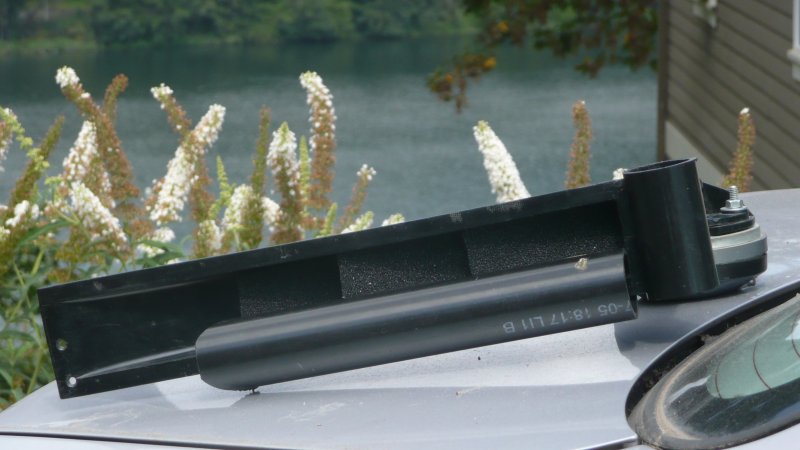
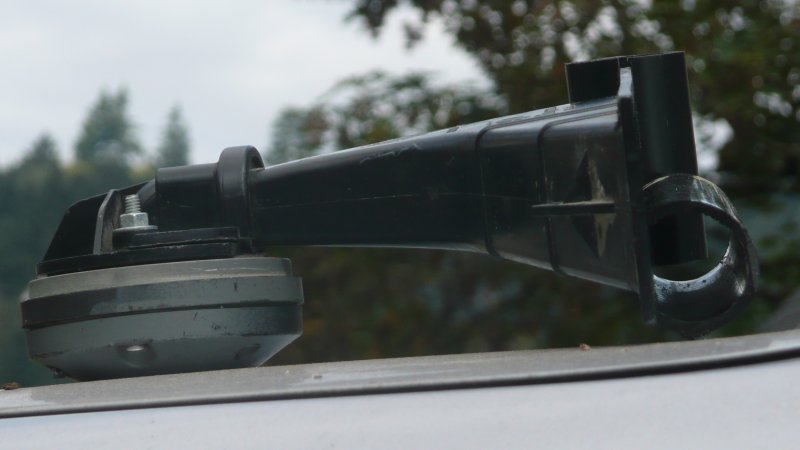
High order modes are waves which don't travel down the axis of the horn. If you draw a line from the center of the throat to it's tangent point on the wall contour, you'll find a point where the wavefronts would have to diffract in order to stay in contact with the walls of the waveguide (or horn.**) The USD horn has a double whammy - first a 90 degree bend, and then a diffraction slot. That's why I called this thread "The Homster" - if you wanted to generate a lot of HOMs, this is the horn for you. But it sounds SURPRISINGLY good when treated. If you've dismissed car audio horns, these tweaks may be a revelation.
First, here's a couple of pictures of the USD horn measurements:
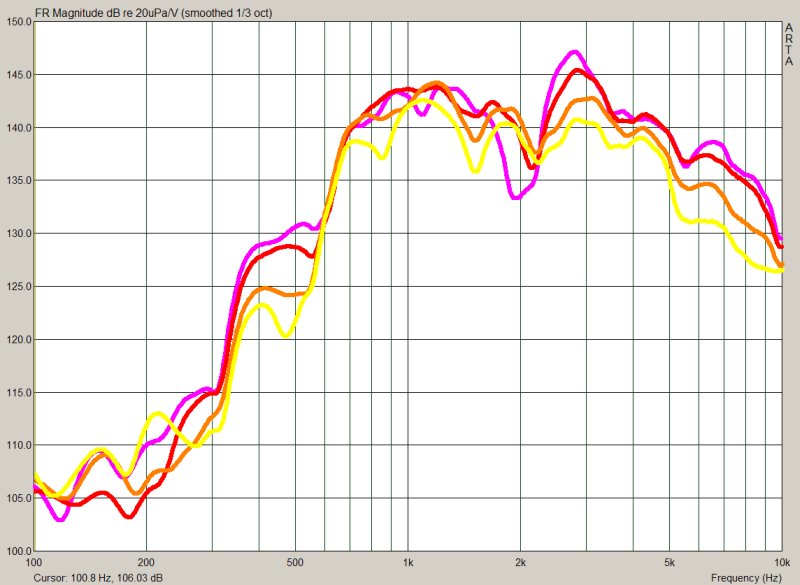
This is the USD horn, completely untreated. (The horn pictured at the top of this therad.)
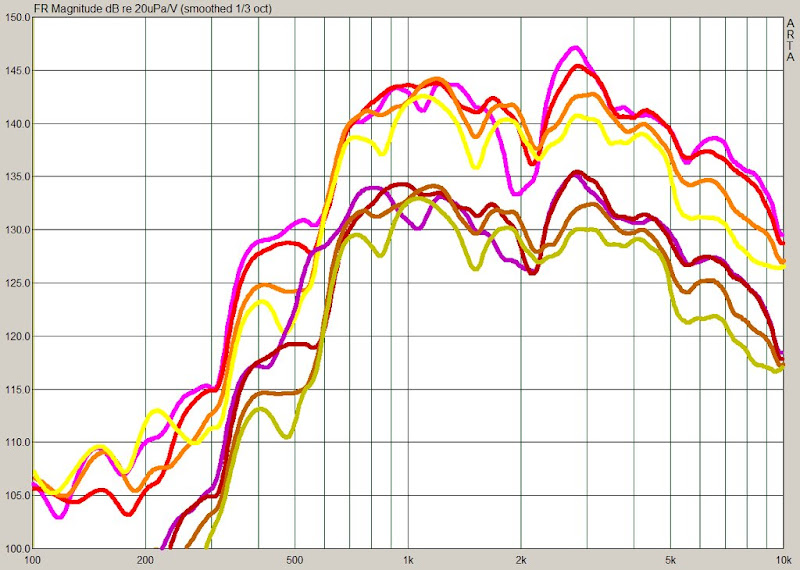
This is the USD horn with a roundover, and no foam.
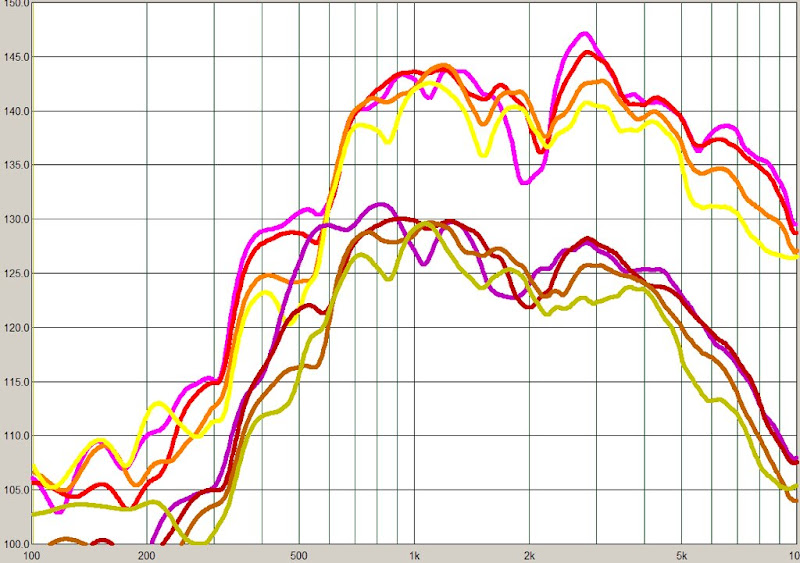
This is the USD horn with a roundover AND foam.
The roundover is "tightening up" the on and off-axis curves. If I had to hazard a guess, diffraction at that unterminated mouth is creating copies of the original wavefront, delayed in time, at the mouth. Since the copies are delayed in time, they're making the frequency response more ragged. This is why the 2nd measurement is smoother, and the polar curves are more similar to each other.
The thing I didn't notice in 2009 was how much LOUDER the low frequencies are in the untreated horn.
In particular, look at what's happening at 350hz. The roundover is reducing the horn's efficiency by about two to three dB in the octave around 350Hz. The foam is taking things a step further, and that octave has taken a hit of almost five dB.
What's interesting is that the QSC waveguide sees virtually NO change below 2khz with the foam.
So what's going on in the USD horn at low frequencies?
I think what's happening here is that diffraction at the mouth is getting reflected back down the throat. 350hz is 40", so one quarter wavelength is ten inches.
I think what we're seeing at low frequencies in the untreated horn is reinforcement of the low frequencies via reflections right back down the throat. And it's most noticeable at 350hz because the horn is about ten inches deep.
Hope that makes sense.
* discussion here: Straight vs Angled Entry Horns - Page 2 - DIYMA.com
** from "Horn Theory Reply" by Geddes : http://www.gedlee.com/downloads/Horn Theory reply.pdf
I posted part II of this thread here:
Audio Psychosis • View topic - The Homster pt2! (or How I Learned More About Fixing a Horn)
Audio Psychosis • View topic - The Homster pt2! (or How I Learned More About Fixing a Horn)
- Home
- Loudspeakers
- Multi-Way
- The HOMster! (or How I Learned How to Fix a Horn)